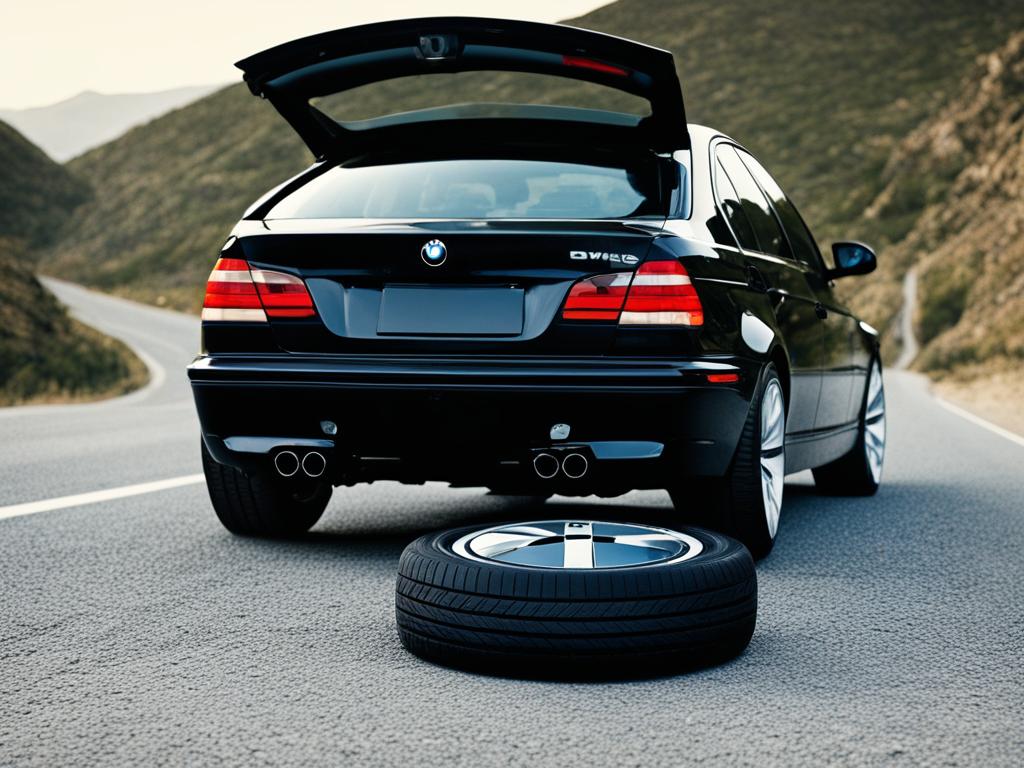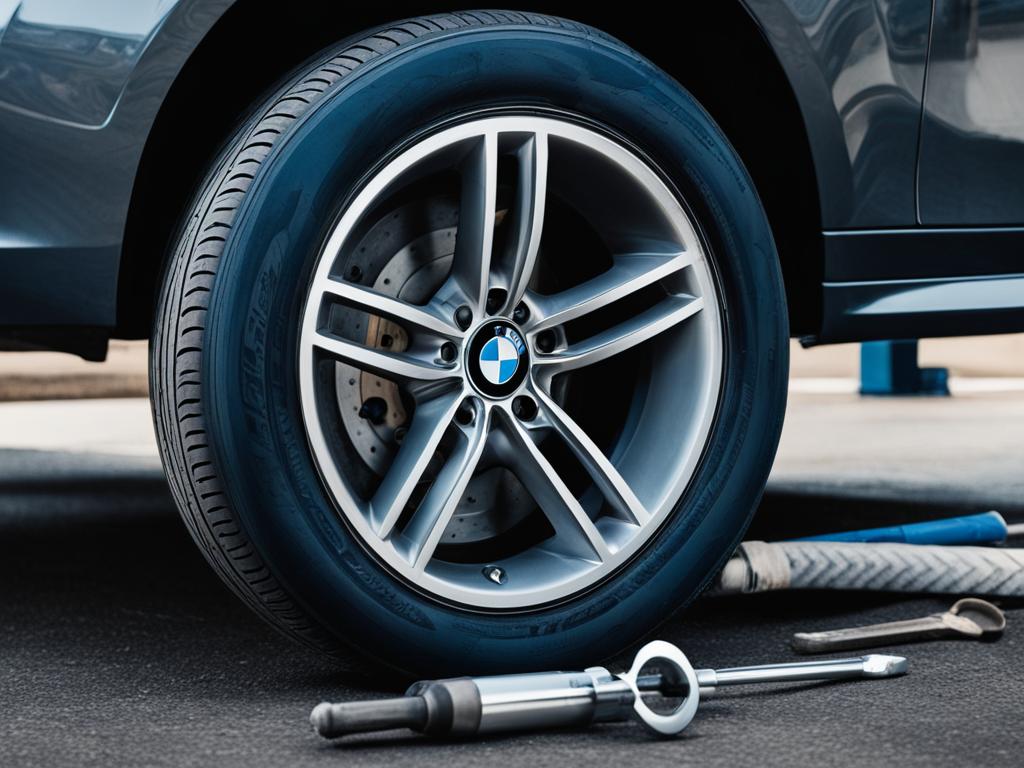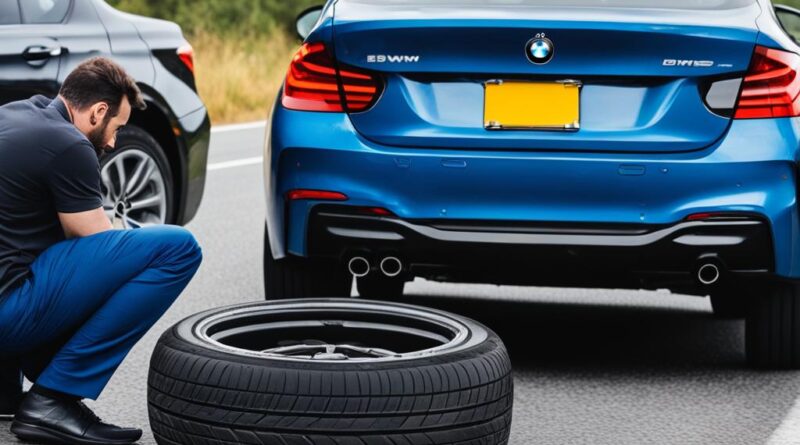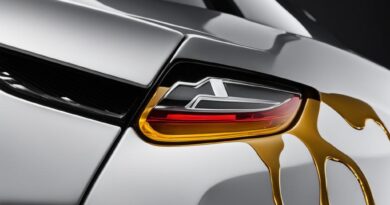Do BMW Have Spare Tires? Quick Facts Guide
Are you wondering if BMW vehicles come with spare tires? In this quick facts guide, we will explore the spare tire options available in BMW models. Let’s dive in and find out what you can expect when it comes to dealing with flat tires in BMWs.
Key Takeaways:
- Most BMW models do not come with spare tires.
- Instead, BMWs are equipped with run-flat tires, allowing drivers to continue driving on a flat tire for a limited distance.
- BMW started eliminating spare tires in the early 2000s, gradually extending this change to all their models as run-flat tires became more popular.
- If your BMW has run-flat tires, you can find information about it in the owner’s manual or by checking the tire labels or dashboard tire pressure warning light.
- Although most BMW models do not have spare tires, there are exceptions, such as some front-wheel-drive-based models that come with spare tire options.
Run-Flat Tires and Their Benefits
Run-flat tires provide BMW drivers with several benefits. Firstly, they allow drivers to continue driving on a flat tire for a limited distance, giving them the chance to reach a repair shop or a safe location. Run-flat tires also have stronger sidewalls compared to regular tires, which helps maintain stability and control even with reduced air pressure. Additionally, using run-flat tires allows BMW to save weight and increase fuel economy.
Some BMW models may also come with a tire repair kit or an emergency tire repair solution, such as the BMW Tire Mobility Kit. This kit includes a sealant and a compressor to temporarily fix minor tire punctures. It provides drivers with peace of mind knowing that they have a reliable and convenient option to address tire issues without the need for immediate roadside assistance.
Benefits of Run-Flat Tires:
- Ability to drive on a flat tire for a limited distance
- Stronger sidewalls for enhanced stability and control
- Weight savings and improved fuel economy
- Tire repair kit for temporary fixes
Overall, run-flat tires offer BMW drivers a reliable and convenient solution to handle tire issues on the road. With their unique capabilities and added features like the BMW Tire Mobility Kit, these tires provide peace of mind and ensure that drivers can continue their journey with minimal disruption.
Determining If Your BMW Has Run-Flat Tires
To determine if your BMW has run-flat tires, there are a few methods you can use. First, you can refer to the owner’s manual, which will mention the type of tires equipped on your specific model. The owner’s manual is a valuable resource that provides important information about your BMW’s features and specifications.
Another way to determine if your BMW has run-flat tires is to check the tires themselves. Look for labels or markings on the tire sidewalls that indicate the presence of run-flat technology. These labels may include terms like “Run Flat,” “RFT,” “SSR,” “ROFM EMT,” “ZP,” or “DSST.” If you see any of these designations on your tires, it’s a clear indication that your BMW is equipped with run-flat tires.

Lastly, you can also take a look at your BMW’s dashboard. If your car is equipped with run-flat tires, you may have a tire pressure warning light on the dashboard. This warning light is a helpful indicator that alerts you when your tire pressure is low. If you see the tire pressure warning light illuminated, it means that your BMW is equipped with run-flat tires.
| Method | How to Determine If Your BMW Has Run-Flat Tires |
|---|---|
| 1. Owner’s Manual | Refer to the owner’s manual to check the type of tires installed on your BMW model. |
| 2. Check the Tires | Look for labels or markings on the tire sidewalls, such as “Run Flat,” “RFT,” “SSR,” “ROFM EMT,” “ZP,” or “DSST,” indicating the presence of run-flat tires. |
| 3. Dashboard Indicator | If your BMW has a tire pressure warning light on the dashboard, it means that your car is equipped with run-flat tires. |
By utilizing these methods, you can confidently determine if your BMW has run-flat tires. Knowing the type of tires your BMW is equipped with is essential for proper maintenance and understanding the options available in case of a tire emergency.
Dealing with Punctures in Run-Flat Tires
When it comes to BMW cars equipped with run-flat tires, it’s important to know how to handle punctures. One of the key features in BMW vehicles is the tire pressure monitoring system (TPMS). This system alerts drivers when their run-flat tires have low air pressure, allowing them to take immediate action to avoid further damage or incidents on the road.
If you receive a TPMS alert indicating low tire pressure, it’s crucial to park your car and assess the situation. Start by identifying the tire that has been punctured. This can be done by visually inspecting the tires or using a tire pressure gauge to determine the difference in pressure among the tires.
Once you have identified the punctured tire, it’s important to assess the severity of the damage. If the puncture is minor and located close to the surface of the tire, it may be possible to repair it through patching. However, if the damage is severe or has reached the sidewalls, it is recommended to replace the tire.
Keep in mind that attempting to drive on a severely damaged run-flat tire can compromise safety and lead to further damage. Therefore, it’s best to take immediate action and address the issue promptly.
BMW’s commitment to safety includes the implementation of run-flat tires and the provision of tire repair solutions. Ensuring the functionality and maintenance of run-flat tires is essential to preserve the safety and performance of your BMW.
It’s important to note that not all tire punctures can be repaired, especially when the sidewalls are compromised. Therefore, it’s crucial to consult a professional tire repair specialist or BMW authorized service center for expert advice and guidance.
By addressing punctures and tire repairs in a timely manner, BMW owners can ensure the continued reliability of their vehicles and enjoy a safer driving experience.
The Option of Spare Tires in BMWs
While most BMW models do not come with spare tires, there are exceptions. BMW started offering some of their cars with spare tires in recent years, particularly the front-wheel-drive-based models like the X1, X2, and 2 Series Gran Coupe. These models were engineered to accommodate the spare tire, with an underfloor cavity for storage. However, not all BMW models, such as the X3, were designed with the spare tire option in mind, resulting in a compromised cargo area when a spare tire is included. The use of a spare tire in BMWs provides an alternative to run-flat tires and can be beneficial for drivers who prefer the traditional spare tire solution.
| BMW Model | Spare Tire Option |
|---|---|
| X1 | Available |
| X2 | Available |
| 2 Series Gran Coupe | Available |
| X3 | Not Available |
The availability of spare tires in BMW models allows drivers to have a traditional tire solution in case of a flat, providing peace of mind and potentially reducing the need for immediate repairs or replacements. However, it is important to note that including a spare tire in a BMW may impact the vehicle’s cargo capacity, especially in models where the spare tire was not originally designed for. Drivers should consider their specific needs and preferences before opting for a spare tire in their BMW.

- BMW.com – Model Specifications
- Car and Driver – “BMW X1 and X2 Will Now Come with a Spare Tire”
Cargo Capacity and Spare Tires in BMW X3
The inclusion of a spare tire in the BMW X3 has an impact on the vehicle’s cargo capacity. While the official listed cargo capacity of the X3 is 28.7 cubic feet, this measurement becomes inaccurate with the presence of a spare tire. The spare tire stage reduces the X3’s cargo area, making it more challenging to accommodate larger items or luggage.
Although the X3 can still accommodate a reasonable amount of cargo, it may not offer as much space as some of its competitors, such as the Mercedes GLC or the Acura RDX, which provide spare tire options and additional underfloor storage.
BMW X3 owners should carefully consider their cargo needs and evaluate the impact of a spare tire on the available space.
| Vehicle | Cargo Capacity (cubic feet) | Spare Tire Option |
|---|---|---|
| BMW X3 | Reduced with spare tire | Varies* |
| Mercedes GLC | 19.4 | Available |
| Acura RDX | 29.5 | Available |
*The availability of a spare tire option may vary depending on the specific model and trim level of the BMW X3.
Replacing Run-Flat Tires and Cost Considerations
When it comes to replacing run-flat tires on a BMW, it is important to consider several factors. If you decide to switch from run-flat to regular tires, it is recommended to replace all four tires simultaneously. Mixing different types of tires, such as run-flat and regular, can have a negative impact on the stability and handling of your vehicle.
The cost of BMW run-flat tire replacement can vary depending on the size of the tire and other factors. On average, the price for a single run-flat tire ranges from $250 to $320. However, it is important to note that this cost only accounts for the tire itself. The overall cost, including labor and materials, can range from $600 per tire to $2500 for all the tires on your car.
Why Replace All Four Tires?
Replacing all four tires is recommended to maintain balanced performance and ensure consistent handling. Even if only one run-flat tire is damaged or worn, replacing all four tires allows for uniformity in terms of tread depth, grip, and overall performance. This helps to maximize safety and maintain the vehicle’s handling characteristics.
Considering the Cost
The cost of BMW run-flat tire replacement can seem significant, but it is important to weigh it against other factors. Run-flat tires are designed to support the weight of the vehicle, even when they are flat, allowing you to continue driving for a limited distance. This added convenience can help you avoid the immediate need for a tow or roadside assistance in the event of a flat tire.
Additionally, run-flat tires can provide peace of mind, as they eliminate the need to carry a spare tire and the associated maintenance involved. This can be particularly beneficial for drivers who frequently travel long distances or in areas where access to repair facilities may be limited.
Ultimately, the decision to replace run-flat tires with regular tires should be based on your personal preferences and driving needs. If you decide to make the switch, it is essential to consult with a reputable tire dealer or BMW service center for expert advice and to ensure proper tire selection and installation.

Replacing run-flat tires on your BMW is a significant investment, but it comes with its advantages in terms of convenience and safety. Considering the cost, tire performance, and your specific driving requirements will help you make an informed decision that best suits your needs.
Conclusion
In conclusion, BMWs have transitioned away from incorporating spare tires in most of their vehicle models, opting for the use of run-flat tires instead. Run-flat tires provide BMW drivers with the convenience and flexibility to continue driving for a limited distance in the event of a flat tire. This tire solution offers peace of mind and reduces the need for roadside assistance or immediate tire replacement.
However, it is important to note that there are still select BMW models that offer the option of a spare tire for those who prefer the traditional tire solution. These models, such as the BMW X1, X2, and 2 Series Gran Coupe, have been engineered to accommodate a spare tire, providing an alternative for drivers who may have specific preferences or requirements.
When it comes to choosing between run-flat tires and spare tires for your BMW, it is crucial to consider your individual needs and preferences. Understanding the tire options available and their respective advantages can help you make an informed decision. Whether you prioritize convenience, cargo space, or personal preference, evaluating the benefits and drawbacks of each tire type is essential in ensuring a safe and comfortable driving experience with your BMW.
FAQ
Do BMW vehicles come with spare tires?
Most BMWs do not come with spare tires. They are equipped with run-flat tires instead.
What are run-flat tires?
Run-flat tires are designed to allow drivers to continue driving on a flat tire for a limited distance. They have a stiff sidewall or an internal reinforcement system to maintain stability.
How can I determine if my BMW has run-flat tires?
You can refer to the owner’s manual, check the tires for labels indicating run-flat tires, or look for a tire pressure warning light on the dashboard.
What should I do if my run-flat tire has a puncture?
If the puncture is minor and has not reached the sidewalls, you may be able to repair it. However, severe damage or sidewall punctures may require tire replacement.
Do all BMW models have the option of a spare tire?
No, most BMW models do not have a spare tire. However, some models like the X1, X2, and 2 Series Gran Coupe offer the option of a spare tire.
How does the presence of a spare tire affect the cargo capacity of the BMW X3?
The inclusion of a spare tire in the BMW X3 reduces the cargo area, making it more challenging to fit larger items or luggage.
What should I consider when replacing run-flat tires?
It is recommended to replace all four tires if switching from run-flat to regular tires. The cost of replacing run-flat tires can vary depending on the tire size and additional labor expenses.
Are spare tires a better option for BMWs compared to run-flat tires?
The choice between run-flat and spare tires depends on personal preference. Run-flat tires offer convenience and safety, while spare tires provide a traditional tire solution.




